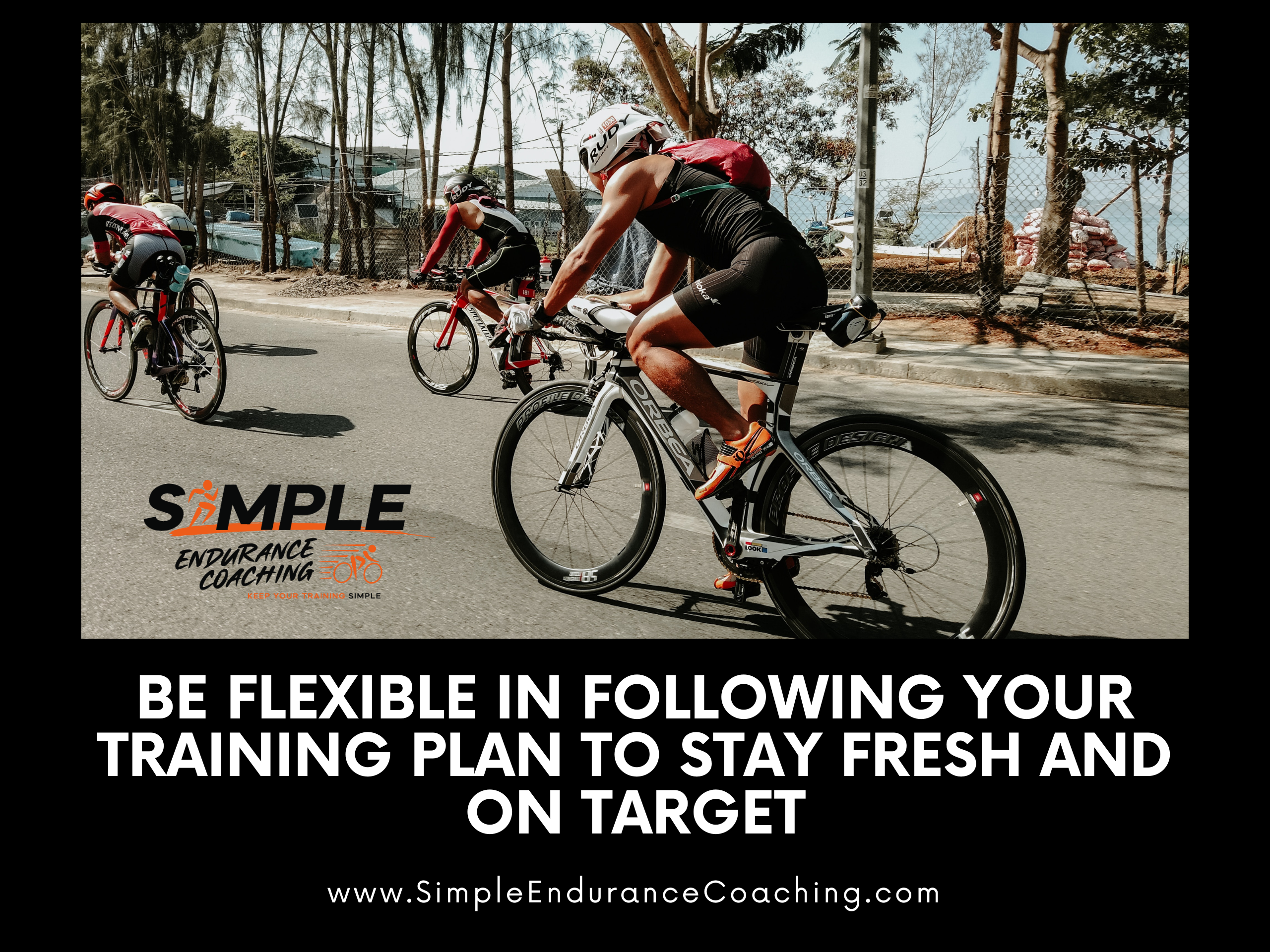Five Ways to Be Flexible in Following Your Training Plan to Stay Fresh and on Target
You know those days when you have a specific workout when life gets in the way?
You panic.
Damn.
How am I going to make this up?
My entire training plan is now screwed up!
Runners and cyclists know exactly what I’m talking about

It’s okay, really
Changing a training plan can seem like a certain disaster where you now will never achieve your goals.
But while having a plan for your training is a good thing, expecting yourself to adhere exactly to everything on the plan is a surefire path to burnout and stagnation.
Several of my clients in the past have worked themselves up over missing workouts and unexpected changes in their life schedules.
Their calls remind me to remind them that we aren’t being paid to train. Missing a workout or two is rarely going to cause an issue, and life sometimes gets in the way of our best-laid training plans.
The simple reality is that our lives as runners and athletes will not be much different if we have to miss one – or even several – workouts.
Training plans are exactly that: plans
When I write a plan for a coaching client, we discuss their life calendar, their available time, and the time of day/ general situation, meaning is there daylight for a run/ride, etc?
What’s most important is that you understand the training goal for that week and what you can move around to accommodate changes in life schedules.
So changing a training plan without stress may mean you can move things around to meet specific goals.
No one workout or even two workouts will ever change the course of your career as a cyclist or runner!
Rest assured that it’s okay to miss a day.
What are the goals of your current training block?
First of all, you need to consider the goal of the current training block.
Are you working on developing endurance, speed, FTP, strength in the gym, or something else?
All of the workouts in your training block should be moving you toward a certain goal.
So if you are changing a training plan, for whatever reason, is it a key workout for that goal?
If so, you can move it to another day; if not, you can probably skip it.
What’s key is that you don’t stack replacement workouts in ways that build too much fatigue.
Knowing the workout plan also helps in changing a training plan
Likewise, the goal of the specific workout is another way of looking at changing your training plan without stressing yourself out.
For example, you may have a four-hour endurance ride on the plan or a 90-minute run.
If the goal is building up endurance, you can perhaps cut down on the total time by doing some tempo intervals.
Decide your priorities for the week and the training block, then changing the training plan can be less of a hassle.
Likewise, if the goal of the workout is to do VO2max intervals, you want to make sure you’re rested enough for that kind of intensity.
Fatigue, HRV are signs of needing a day off
And sometimes changing your training plan is needed because you’re tired, or just not in the right headspace, especially if you’re trying to do really hard intervals.
Of course, sometimes you are tired and need to take a day off, regardless of what the schedule says.
If you start a workout and your legs just aren’t responding, that could be a sign you need more recovery.
Using the HRV4Training app or another heart rate variability app to monitor your training readiness is a good way to know if you truly need to limit intensity or take a day off.
And please, give yourself a break if you take the day off!
If you take the day off from your training, use the time well!
Sometimes you need to start a workout to realize you’re not ready.
It’s far better to turn around and go home than to beat yourself over the head and finish to risk building too much fatigue.
Sticking to the plan can be important – only at certain times
There are some times in the training year, however, when you don’t want to change the schedule if possible.
In particular, if you are targeting a particular event, it’s important to plan your taper.
Changing your training plan at this point is tricky.
You want to maintain the intensity, not get too much intensity, and rest enough to be ready for your event.
Also, if you have multiple-day events like a stage race, and you are planning similar multi-day workouts, it’s important to string together that training, if possible.
Strength training needs long-term training plan
Strength training is always a factor in changing a training plan to deal with daily challenges.
For example, if your training block is all about building strength, then get to the gym the next day if you have to miss a workout.
However, lifting two days in a row is not usually a good idea.
Nor is it a good idea, if your goal is building strength, to do a rescheduled set of hard intervals right before a gym strength training session.
During the race season, you might replace a strength session with a yoga session if that’s what you need.
So again, it’s important to understand what your goals are and how your training schedule reflects your priorities.
Five things to consider when changing a training plan
So here are some general guidelines for changing a training plan to minimize stress.
- There is no one workout that will make or break your preparation. Skipping a day is not a big deal. Use the time off and do something productive – or take a nap.
- Unless you are a professional athlete getting paid to train, you’re getting paid to do something else. Your family, job, and home life are more important. Consider your priorities.
- If you have to skip a workout, consider the goals of the training block to determine whether you should skip the workout, reschedule it, or move a different workout.
- If you have to change the date of a workout, it’s generally better to replace a workout than to stack workouts. For instance, if you have to move an interval session to a Wednesday when you have a moderate endurance workout scheduled, just do the intervals and not both.
- Use a heart-rate variability app or be aware of your fatigue to monitor whether you should ignore the training plan and take a day off.
Want to know more about what you can achieve?
If you liked this article, please share it with others. I support a limited number of cyclists and runners achieve their goals with more strength, endurance, and mobility. Contact me or sign up for Virtual Coffee so we can discuss your goals, ask questions, and talk about making your endurance training more effective, fun, and Simple. You can also opt-in to receive my weekly blog posts about what works in endurance sports. Paul Warloski is a:
- USA Cycling Level 3 Coach
- RRCA Running Coach
- Training Peaks Level 2 Coach
- RYT-200 Yoga Instructor
- Certified Personal Trainer




